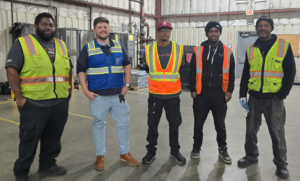
Disruptors like today’s coronavirus pandemic abruptly cause major change in many sectors of society. In many cases, these changes remain permanent. Disruptors cause trends to be sidetracked, stopped, or even accelerated.
COVID-19 and Digitalization:
One trend that COVID-19 is accelerating is the adoption of smart technology by the global supply chain. Smart technology in the warehouse, often called a smart warehouse or wired warehouse, is rapidly gaining ground, especially as the e-commerce sector presses to keep up with the increased demand of goods by consumers. Already underway, the growth of digital industrial warehouses is speeding up as it becomes evident that shoppers will continue to adapt to ordering online instead of going to the store. Merchants large and small are part of this phenomenon. Not only are giants like Amazon and Walmart lining up to increase warehouse efficiencies, but others such as Macy’s and Shopify are also building or overhauling their warehouses, evolving into more sophisticated and digital facilities, and employing advanced software and robotics.
Online Retail and E-Commerce:
The trend toward smart warehouses is a decade old, due in large part to the growth of online retail and e-commerce business. Now, online shopping has accelerated as customers are choosing to stay home and prevent undue exposure in traditional brick-and-mortar stores. The need to develop new smart warehouses is additionally driven by workers’ concerns for safety. The pandemic is causing us to take a new look at smart warehouses to address worker safety issues as well as the increased demand for one-day shipping.
Supply Chain Sourcing:
COVID-19 also brought about an abrupt disruption in the global supply chain. Before the pandemic, many American companies depended heavily on imported products or raw materials to supply many of the goods they sold to consumers. Supply chain experts have warned for years about the high risks of overdependence on foreign markets. Despite these warnings, many companies continued to use lower cost imports to maintain profitability while meeting consumers’ demand for affordability.
The pandemic has forced these companies to rethink their sourcing strategies, as the sudden disruption brought this risk of over-reliance on supply chains outside American control into sharp focus. However, decreasing dependence on foreign imports brings with it another big problem – higher prices. Goods sourced from American suppliers and other Western countries cost more to produce because our workers enjoy more rights and a higher standard of living. They demand benefits, safe working conditions, and higher pay, all of which contribute to higher costs.
Robots Reduce Cost:
This is where smart warehouses step in. Smart warehouses can bridge the profit gap by lowering logistics costs. Cheap imports still had to factor in a heavy reliance on sometimes inefficient logistics that added to the total downstream cost to consumers. By sourcing goods closer to home, but leveraging new logistics efficiencies, sellers can maintain relatively stable prices for consumers. The products cost more to make, but less to deliver. Some studies have indicated that smart warehouses can lower operating costs by 70%.
Smart warehouses have a lot more going on inside than conveyor belts and bins. Smart machines and robots populate these warehouses. ID tags on inventory communicate with floors, walls, and ceilings that tell them where to go and confirm their movement through the warehouses. Equipment such as fork lifts, shelves, carts, and conveyor belts talk to each other as well, and also to their human counterparts. Inventory items signal their locations and movements. When items leave these wired facilities, bar codes, sensors, and radio ID tags aid in tracking them to their final destinations. In some of these digital warehouses, workers even wear smart eyeglasses that provide direction regarding the placement and movement of merchandise.
Robots Enhance Human Work:
In smart warehouses, robots can also handle routine, mundane, and dangerous tasks better than people, freeing us up to tackle the tasks that are more complex. In “What robots do (and don’t do) at Amazon fulfillment centers, an Amazon Staff Writer describes how robots “keep employees focused on tasks where high judgment is needed. For example, humans can look at a pallet of maple syrup and understand how best to unpack it. Robots aren’t able to easily detect what kind of liquid is in a container or if it’s spilled within its packaging. Humans can easily understand what they’re unpacking and then find a way to safely unpack it without causing damage.” Rather than displacing human workers, robots can enhance the warehouse workforce.
It may seem like the future is approaching quickly, as our economy adapts to the new realities of a changing world. Fortunately, human ingenuity is an incredible force allowing us to overcome challenges to achieve our goals more efficiently, economically, and safer than ever before. While some may fear the rapidly changing economic landscape, most experts agree that we have nothing to fear, and everything to gain, from innovative technologies. Far from replacing people, smart warehouses are improving our ability to serve customers and enhance job satisfaction.
In Conclusion:
Many new technologies throughout history have been disruptors. (Consider the mobile device that well over half of you are using to read this post.) Most new technologies have also caused apprehension at one point. However, many would argue that our modern standard of living and the quality of our lives is the best in human history because of these disruptive technologies. Smart warehouse technology is driving us closer to a world where we can accomplish more while being happier and safer doing it.
While most of Pace’s facilities do not yet utilize smart technology, many of our customers’ docks – where we work – do. We are looking forward to where the future brings us.











